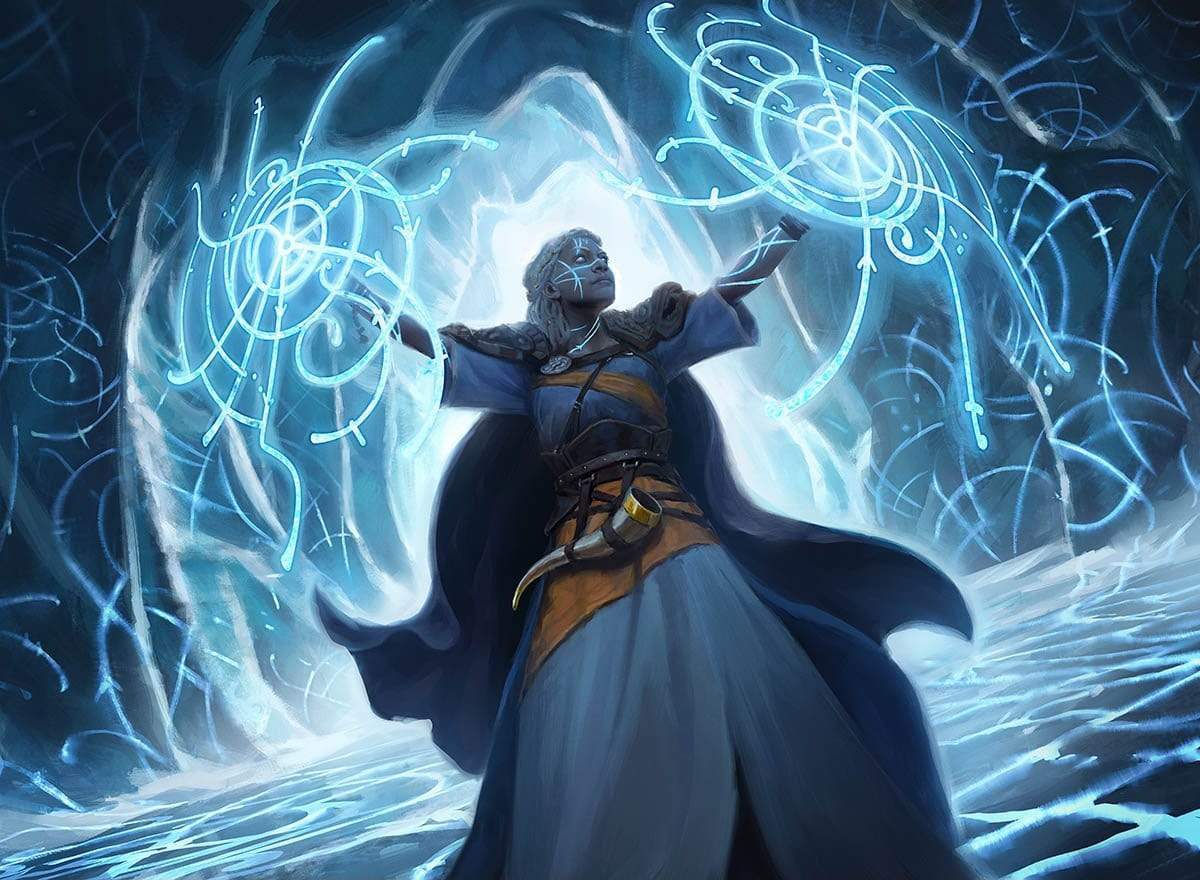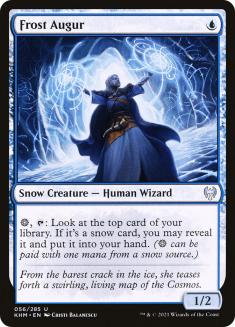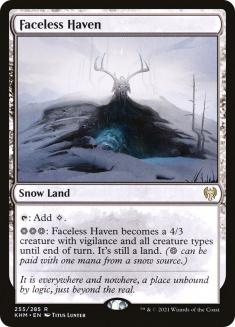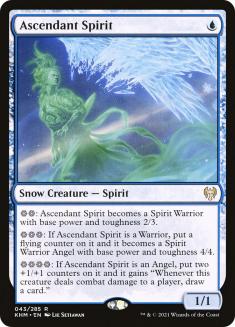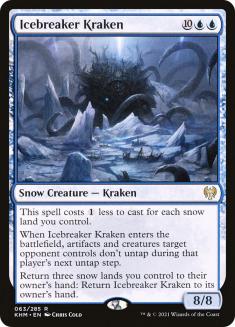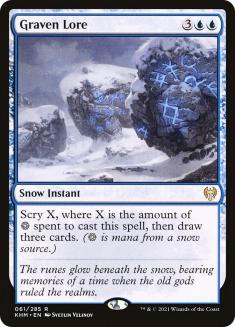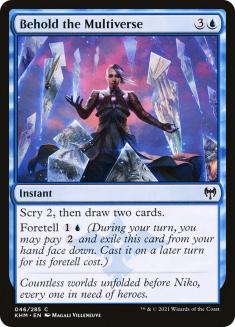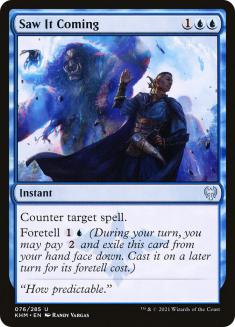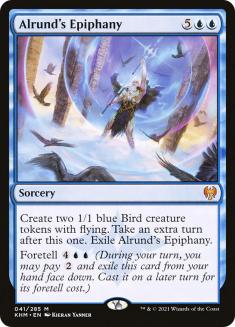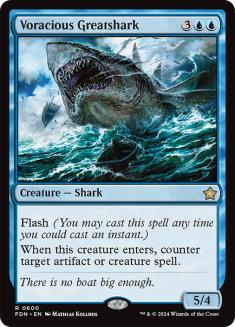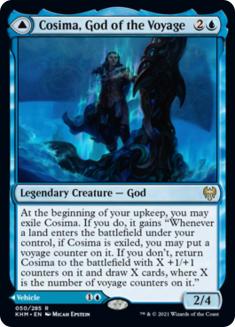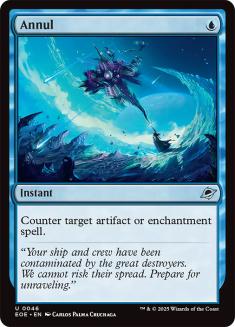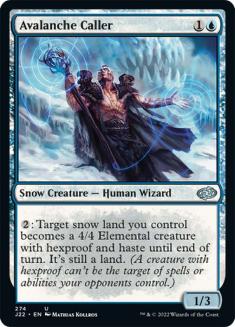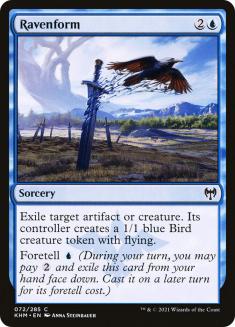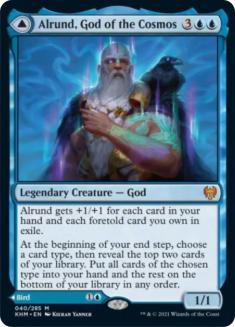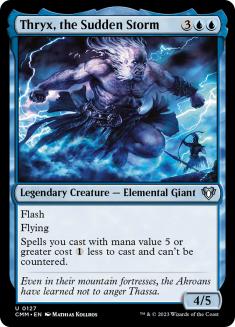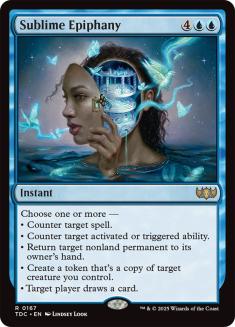This past weekend Kellen Pastore Top 8’ed a Standard Challenge on Magic Online (MTGO) with a fun brew of his, Mono-Blue Snow❄. Being a fan of Mono-Blue strategies, I was immediately drawn to the deck and I’ve found it to be a ton of fun to play, generating some dynamic, tense games of Magic. I have a lot of thoughts on how to tune the deck; think that, depending on how Standard ends up looking, the deck has the potential to be quite good; and also think that, even if Standard lands in a place where the deck isn’t well-positioned, there’s still a lot to learn from this deck about snow decks in general that can be applied elsewhere.
Creatures (22)
- 2 Gadwick, the Wizened
- 4 Brazen Borrower
- 2 Voracious Greatshark
- 4 Ascendant Spirit
- 4 Cosima, God of the Voyage
- 4 Frost Augur
- 2 Icebreaker Kraken
Lands (28)
Spells (10)
Sideboard

Mono-Blue Snow❄ is a midrange deck capable of aggressive starts thanks to Ascendant Spirit and Brazen Borrower but also capable of going long thanks to the sheer amount of card advantage it has access to. So, what are the draws to playing Mono-Blue Snow❄? As I see it, there are three big appeals to the strategy.
Frost Augur is an incredibly unassuming card that’s actually kind of remarkable in practice. Kellen’s list has 38 snow cards, meaning that any individual Frost Augur activation is about 63% to get you an extra card. Even my updated list still has 34 snow cards, putting the odds at 57%. For how small this mana investment is, the potential card advantage you’re receiving here is kind of absurd. The card is also just a 1/2, able to hold back 1/1 tokens or block opposing copies of Usher of the Fallen or Seasoned Hallowblade; sure, it dies to Stomp, but I’ve largely felt like the body is relevant enough that the card is quite a bit better for being a creature instead of an artifact or enchantment.
The thing is, these odds of getting an extra card off your Frost Augur activation work more in your favour than they should because of the degree of agency you have with activations. If you really want to draw spells, then you can activate your Augur in your upkeep; if you don’t get that extra card from the Augur activation, it’s because you saw a spell that you’ll be drawing for your turn, so you don’t mind that the activation failed, and if you do get that extra card, then you’re likely clearing a land from the top of your deck that you wouldn’t have wanted to draw for the turn. So if you really want to draw spells, then those 57% odds of revealing a card to Augur are dramatically better than they sound because not revealing a card in that situation is actually a good thing.
This works in reverse too. If you really want to draw a land then you shouldn’t activate your Augur in your upkeep, instead taking a draw for the turn first and then, if you still want to, activating your Augur in your main phase. If you drew a land for the turn, then it doesn’t matter whether your subsequent Augur activation is successful or not because you got what you wanted, a land for your turn. Meanwhile if you didn’t draw a land for the turn, then you get another swing at it thanks to the Augur. This degree of agency you have over these activations means that you may only be revealing a card to the Augur 57% of the time, which is already a really high percentage for the low mana investment, but you’ll be dramatically more consistent at finding what you want to draw, whether lands or spells.
This works well for two reasons. One is that the high count of snow cards in the deck makes the raw hit-rate of Augur high, which is in itself a big draw to playing an actual snow deck like this. The other reason is that by being mono-colour you get to have an entirely snow manabase, enabling the aforementioned play patterns and thus offering you this degree of agency. The moment you start adding Fabled Passages or DFC lands to your deck to enable a second colour, both the hit-rate and the Augur play patterns get muddied and weakened as a result.
Whilst we’re talking about the manabase, Faceless Haven feels like a ludicrous Magic card when you can support it properly and the best creature-land we’ve had in Standard since Mutavault. The card lets you turn the corner quickly due to how large it is, whilst vigilance helps you attack and block with it in the same turn cycle if needed in the very-late-game and also makes its activation cost secretly cheaper than it looks; often that vigilance ends up providing the extra mana you’d need to hold open a counterspell on your opponent’s turn.
Being a mono-colour snow deck means you get to activate Faceless Haven more reliably due to your manabase not being muddied with non-snow lands such a Pathways, and enables you to play the full four copies of Haven without leading you to having too few coloured mana sources.
Whilst Frost Augur and Faceless Haven both seem very compelling once you’ve looked at them for any amount of time, despite its wall of text Ascendant Spirit is a bit subtler of a draw to being a dedicated snow deck. There are definitely matchups where the card has not felt great to me, with a notable weakness to the card Skyclave Apparition. Removal that doesn’t really care about the size of your creature is effective at making the huge mana investment going on here look kind of embarrassing.
So why do I think Ascendant Spirit is a big draw to this deck? Put simply, it’s an incredible Plan B. There are matchups where the card is weak, but often those are matchups where it also just feels unnecessary, so you don’t mind sideboarding it out or keeping it in and just not investing too much mana into it.
But if your deck lines up poorly in a matchup, or you’re going to struggle to keep up with your opponent’s late-game, the card is just incredible at closing the door quickly when backed up by counterspells. This has felt particularly the case against Mono-Green Food, a matchup that would normally be quite challenging for a deck like this; however, some amount of the time you cast Ascendant on Turn 1, pump it a bunch, and have a counterspell ready for their copy of The Great Henge, and there’s nothing your opponent can do but roll over and die.
It feels weird to say that a card that I don’t think is just outright great is a big draw to an archetype, but Ascendant Spirit serves such a unique role that’s so hard to fill in this way with any other card really. Whilst I think the card has its weaknesses and places where it doesn’t shine, it’s still very much a reason why I like the idea of playing Mono-Blue Snow❄.
Regarding the other snow payoffs, Icebreaker Kraken feels like a fine card to play, but I’m not sure the rate on the card on it is really good enough for me to want to play it. Often you’re looking at it being a six-mana 8/8 which is not thrilling, and the ability to keep your opponent’s battlefield tapped down just hasn’t come up for me that much. Sure the rate on the card improves as the game goes on longer, and there’s some synergy here with Gadwick triggers tapping down opposing permanents, but I’m unconvinced.
Graven Lore is a solid sideboard card for matchups where you really need the additional card advantage. I considered adding some copies to the maindeck, but even in a dedicated snow deck I think Graven Lore is generally a touch worse than Behold the Multiverse as a maindeck card due to how flexible foretell is.
On that note, the biggest change I’ve made to Kellen’s initial list was to add a foretell package to it of Behold the Multiverse, Saw It Coming, and Alrund’s Epiphany. I think these foretell cards are all quite underrated at the moment and that the strength of the mechanic will become evident as time goes on.
People compare Behold the Multiverse and Glimmer of Genius but I don’t think these two cards are even in the same ballpark; so often with Glimmer you’d hold open your four mana, your opponent would take an action on their turn, and you’d be forced to choose between resolving your card draw spell whilst letting your opponent gain advantage too or interacting with your opponent but wasting mana in the process. Behold the Multiverse is incredible in contrast because its foretell ability leads to you so rarely wasting mana in those situations where you’re forced to interact.
Saw It Coming is in my mind close to a strict improvement over the copies of Neutralize in the original list because foretelling it means you’ll be able to use more mana safely at sorcery speed on future turns. If you’re willing to invest the two mana to foretell now then on your next turn you’ll only need to hold two mana open to still be representing your Cancel effect, meaning you get an extra mana to play with on your turn.
This is already great, but if your opponent doesn’t cast anything that needs countering next turn, or the turn after, suddenly it’s like you’re profiting on mana for this foretell investment since that’s multiple turns where you’ve only had to hold open two mana rather than three. The benefit of the foretell on this card is subtle, but as someone who has cast a lot of Cancels in Standard before, you can really feel the difference.
Alrund’s Epiphany I am less sure on than the previous two cards, but so far it has been playing well for me and has certainly felt like a more powerful top-end card than Icebreaker Kraken. If you’ve developed a decent battlefield of flyers, the extra turn can mean you’re suddenly threatening to kill your opponent before long, and the two 1/1 flyers the card provides mean that, even when you’re behind if you resolve this card and get those two chump blockers in the process, it can let you find your feet in a way that previous Time Warp variants haven’t really helped towards.
These are the two cards Kellen said disappointed him throughout the tournament he played. Voracious Greatshark feels clunky to me, being expensive, hard to line up well, and often trading down for a Bonecrusher Giant, so I find myself agreeing with him completely and am happy to just cut it outright.
Whilst I’m not ecstatic with Cosima, God of the Voyage, and have cut a copy of the card as a result, she has still been performing solidly for me. The Cosima side of this DFC is a bit less exciting in this deck than she might be elsewhere due to the absence of Fabled Passage, a land that I’m not keen to introduce to the manabase since it conflicts with Frost Augur, but Cosima has still done solid work for me just as an early body that nets a bit of card advantage if the game stalls out.
In this deck I’ve been more impressed with The Omenkeel half of the card, which acts as an efficient play that’s relatively easy to crew thanks to all your one-mana creatures and that helps you hit your land drops.
These are all cards I considered and that didn’t quite make the cut for me in my current build of Mono-Blue Snow❄, but they all feel very close to playable here and it wouldn’t surprise me if any of these end up in the 75 given more time to work on it, so I felt it worth sharing these ideas with you.
With all that said, here’s where I am currently with Mono-Blue Snow❄:
Creatures (18)
Lands (26)
Spells (16)
Sideboard

The deck has been performing pretty well for me so far, and I’m excited to play it more as Kaldheim Standard evolves over the next couple of weeks. It has a bit of an Edgewall Innkeeper problem, but in exchange the deck beats up on Yorion, Sky Nomad decks, so keep an eye on how things pan out in respect to the popularity of the Yorion decks.
Good luck to all those who decide to cover the battlefield in glorious snow!

